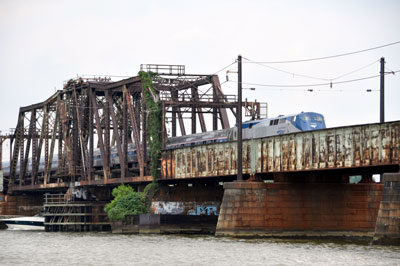The region's ability to accommodate anticipated growth in freight, passenger, and commuter rail traffic in coming decades will depend in large part on the future of the region's only Potomac River freight rail crossing -- a 2,500-foot span between the District of Columbia and Virginia known as the Long Bridge.
Built in 1904, the Long Bridge connects the District, Maryland, and the Northeast to Virginia and points south. Freight and passenger rail traffic up and down the East Coast, and between Virginia and the District, must share the two-track crossing.
|

|
|
|
About 90 trains use the Long Bridge on an average weekday. Around a third of those are freight trains operated by CSX, the bridge's owner. The remaining two-thirds are Virginia Railway Express (VRE) commuter trains connecting the Northern Virginia suburbs with job centers closer to the urban core, or Amtrak intercity passenger trains serving East Coast destinations.
Freight and passenger trains currently share the Long Bridge's two tracks with relatively few schedule conflicts. But growing demand for freight and passenger traffic in coming decades will lead to further strain, especially since CSX, as the bridge's private owner, will retain the right to prioritize its own freight traffic over passenger traffic should the market demand it.
That's why planners at the District Department of Transportation, in a study funded by the Federal Railroad Administration, are examining various alternatives for expanding the bridge's capacity. At a stakeholder workshop held as part of the study, participants said that improvements to the bridge should increase total capacity as well as make accommodations for double-stacked and electrified trains, and eventually high-speed rail.
DDOT's study began with over 100 alternative configurations, which were narrowed to just six through a process that included public input from the public and various stakeholders, including CSX, VRE, and Amtrak.
All of the alternatives but one -- a "no build" option required to be considered as part of such studies -- would double the bridge's capacity from the two existing tracks to four. Some officials have called for separating freight and passenger traffic completely so as to eliminate scheduling conflicts that might hinder the expansion of passenger rail service.
In addition to extra tracks, several of the alternatives also provide new river crossings for a variety of other transportation modes. One adds a path for pedestrians and cyclists, while others add room for streetcars and automobile traffic.
The DDOT study is due to be complete by early 2014. Improvements to the bridge are unlikely to be made anytime soon, as it remains to be seen whether CSX, the passenger railroads, or the states will take the lead in funding and constructing any expansions. Action will also require extensive collaboration among these and other organizations and agencies, including the National Park Service and the Coast Guard.
As the region's only freight and passenger rail crossing of the Potomac River, the Long Bridge is a critical link in the region's transportation system as well as along the East Coast. Future growth of freight, passenger, and commuter rail services in the region -- and the economic activity that supports -- will depend largely on the future of Long Bridge and its ability to handle these new demands.
Related Links